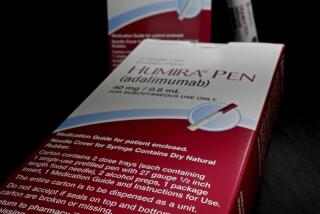PERSONAL HEALTH : THE PHARM REPORT / KATHLEEN DOHENY : Something Catchy? : Firms That Come Up With Clever Names for New Drugs Say It’s a Tricky Business
- Share via
Mommy, where do drug names come from?
Well, Junior, there are actually specialty companies in the business of naming drugs. Among them: Interbrand Corp., based in New York, and NameLab in San Francisco.
“In the old days,” says Roy Walker of Merck & Co. Inc., “a group of people would just sit down and come up with a name. It was fairly informal.”
Nowadays, specialty firms lend a new sophistication to the age-old process. Charles Brymer, president and chief executive officer of Interbrand, says that process is time-consuming and exhausting. “It usually takes two months to find an acceptable name,” says Brymer, who relies on a staff of copywriters and computer programs. Companies also consider input from focus groups consisting of doctors, pharmacists and consumers.
What’s in a Name?
To boost sales, a drug name should be easy to remember, especially for physicians and pharmacists.
* Some say a drug’s brand name shouldn’t sound too much like its generic name, because when the patent expires the brand name really needs to stand out.
* A prescription drug name should be easily decipherable when written, a real challenge considering doctors’ notoriously bad penmanship.
* A good drug name sounds powerful; just reading the label should make you believe your backache will soon be history.
* “A drug name should not sound too much like a drug already on the market,” Walker says. A dissimilarity not only helps sales but also minimizes the chances of dangerous, even deadly, mix-ups.
* A drug name doesn’t have to mean anything.
Human Versus Machine
Some experts swear by computer programs, but Ira Bachrach, president of NameLab, sniffs that “computers have no sense of meaning.” He prefers to name drugs using morphemes--small meaningful elements that make up words. There are an estimated 6,200 morphemes in the English language, says Bachrach. Some examples: ol, in.
Trick of the Drug-Naming Trade
They call them “line extensions.” Rather than come up with a whole new name, you add to a name. Take Tums E-X, the heavy-duty version of Tums antacid.
“The (original) name is already trusted and well-known,” says Frank Rathbun of the Nonprescription Drug Manufacturers Assn.
“Plus, if you give each product a different name, you spend more promoting it.”
Trick of the Trade II
Drugs meant to work on a specific body part can be a piece of cake to name.
Proscar, for instance, is a new drug to shrink an enlarged prostate.
Other Examples
When Johnson & Johnson asked Bachrach’s firm to find a name for its new anti-wrinkle cream, he turned to the morpheme for new, nov.
Then he tagged a re on the front and an a at the end. Renova was born, a name that Bachrach says delights the manufacturer.
* One of the first ibuprofen pain relievers after the original’s patent expired, Nuprin is actually a shortened version of “new ibuprofen.”
Glitches
Even if a manufacturer loves the suggested name, there are potential snags. The name might not pass muster with the Food and Drug Administration or the federal Patent & Trademark Office. “There are a million trademarks registered or pending,” says David Bucher of the patent office, “and about 58,000 (are) in the pharmaceutical class.”
The Payoff
Seeing your name in print. “Nix,” says Kathy Bartlett of Burroughs Wellcome Co., proudly speaking of the company’s head lice cream rinse. “ViaSpan,” Brymer says slowly, stretching out each syllable of the name for an organ transplant solution. “Doesn’t that just say it all?”
Quoting
One drug-namer recalls a conversation shortly after he found his life’s work. “Soooo, you name pills and stuff?” his brother asked. “You’re not kidding? And it takes all day to do this?”
More to Read
Inside the business of entertainment
The Wide Shot brings you news, analysis and insights on everything from streaming wars to production — and what it all means for the future.
You may occasionally receive promotional content from the Los Angeles Times.










